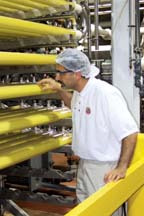
For example, bacteria and spoilage organisms in milk are easily removed by microfilters with pore sizes ranging from 0.1 to 20 microns. Canada’s Dairyland dairy, now a unit of Saputo, promotes this benefit with Pure N Fresh microfiltered milk. Ultrafiltration units with pores ranging from 0.01 to 0.2 microns have been shown to affect the appearance and sensory properties of fluid milk because of the protein molecules that can be retained and then added back. Molecules that manage to work their way through the membrane exhibit different organoleptic properties, with a richer mouthfeel attributed to the squeezed proteins. A significant body of research on the sensory, nutritional and bacteria-removal effects of membrane filtration has been compiled in the last decade by David M. Barbano and other food scientists at the Northeast Dairy Foods Research Center at Cornell University. Research on protein standardization via ultrafiltration shaped the development of HP Hood’s Simply Smart low- and no-fat milk.
Sermet Yalcinkaya, president of JCS Controls Canada Ltd., Brampton, Ont., has engineered a microfiltration system for one dairy and currently is recommissioning a filtration system for in-line processing at another firm. A native of Ankara, Turkey, Yalcinkaya did his undergraduate work in food engineering at Middle East Technical University. He received a doctorate in dairy science from University of Alberta in Edmonton, Canada, and was technical services manager at Dairyworld Foods before joining JCS. Food Engineering recently spoke with him about advancements in the field of filtration science.
FE: How does microfiltration affect fluid milk?
Yalcinkaya: All microorganisms, whether living or dead, are removed from the stream. Microfiltered milk is consistently whiter than milk of comparable butterfat and has a richer mouthfeel. The thinking is that, by forcing the fluid through very small channels under relatively low pressures of 60 to 70 psi, we induce physical changes in the protein molecules and cause the milk to look and taste differently. This is the only logical explanation to what is a clearly observable phenomenon. Unfortunately, I don’t have documentation to prove the whitening properties of microfiltration. The fact that the milk appears to be whiter is good enough for the marketing people. There’s little motivation to commission research to learn what actually is occurring at the molecular level.
FE: How receptive is the market to microfiltered products?
Yalcinkaya: In Canada, one processor (Dairyland) installed a microfiltration system and developed a market for fluid milk that commands a 10 cents a liter premium. It was a Bactocatch system from Tetra Pak, with proprietary modifications. The processor was able to market this product sufficiently to convince consumers that this product was of high purity and better tasting. This level of awareness allowed one of our clients to piggyback with a similar product processed in a system that made use of an existing aseptic surge tank. We were able to create a membrane system that cost less than $1 million and could output 6,000 liters an hour.
An American client was interested in developing a similar system. We knew the nitty-gritty details of the additional costs, and it really came down to the market-development needs in the U.S. When those figures were presented, the client backed off.

Yalcinkaya: I think organic milk would be a candidate. Consumers of those products are willing to pay a few cents a liter extra because of the purity of the raw material. It would be much easier to sell them on the improved nutritional value of a milk product that has been subjected to minimal heat treatment because of filtration. The richer taste of the product would be an additional value-added feature.
FE: How would you engineer a processing system that incorporates microfiltration?
Yalcinkaya: You would have to have a fairly efficient upstream system in the plant, because membrane systems are very susceptible to fouling from any incidental fat that comes in contact with the filter. You also would need to have a filter with a pore size that best fits your particular process. You wouldn’t want to screen out the larger proteins that add to the nutritional mix.
Because fat is a component in milk that basically shields microbes from heat treatment, it might make sense to have a small UHT system to treat the cream component. This would have to be done in-line, with blending occurring in a sterile, enclosed unit. A sterile aseptic surge vessel would then be needed to handle the blended product downstream. An ESL-grade packaging system with HEPA filters, UV lights and other sanitary devices would be needed, and the packaging itself would be a critical component. If a carton is used, a heavier gauge would be needed; if it’s a jug, some kind of thermal seal would be advisable under the cap, since the product is almost sterile and any contaminant that got in would have a field day.
FE: What kind of footprint would the surge tank have?
Yalcinkaya: Assuming packaging is synchronized with processing capabilities, it needs to have a capacity 1.5 times greater than your upstream capacity. If that’s 2,000 gallons an hour, a 3,000 gallon surge tank would be required. A tank of that proportion would have a diameter of 10 to 12 feet, with a height of perhaps 12 to 14 feet. During microfiltration, you want to run product at 40º to 50º C, higher than under normal conditions. Otherwise any residual fat could crystallize and foul the filter. At the higher temperature, fat tends to remain in liquid phase.
FE: Is the precision of membrane manufacturing expanding the utility of filtration in food processing?
Yalcinkaya: You can’t expect pore sizes of a precise diameter. The pores are really channels, and deviation in pore size is inevitable. But tolerances are getting tighter, and the technology is changing.
One of the more exciting developments is sintered stainless-steel microfiltration membranes. Graver Technologies in Glasgow, Del., developed the membranes. Eurodia Industries, a French separation-process company that works with electrodialysis, ion exclusion chromatography, ion exchange resins, microfiltration and nanofiltration technologies, recently installed the first commercial system in a European sugar operation. I’m hoping stainless-steel membranes will get food-grade (3A) certification. We have at least a couple of clients who would love to try these, partly because of their ability to handle CIP steam and chemicals. The problem is that 3A welding regulations currently preclude stainless steel filter use in North American dairy applications.
FE: Where do you see this technology being applied?
Yalcinkaya: Membrane processes in general are more widely applied in Europe than here, even though stainless steel membranes were developed here. The energy-cost savings that are possible with filters help to justify the investment in Europe and other parts of the world. Using filtration to concentrate something in a stream from 5 percent to 15 or 20 percent concentration also requires equipment with a much smaller footprint than conventional processes using, for example, an evaporator. The space savings alone are almost half, and the product that emerges is more nutritious because it hasn’t been subjected to as much thermal abuse.
FE: Is the technology gaining inroads in North America?
Yalcinkaya: Since the early 1990s, filtration increasingly has been used as an alternative to evaporators, at least in dairy expansion projects. Processors of gelatin, vegetable oil and other products also are replacing evaporators, in part because evaporators are tough to clean.
Filtration is being used with juices, either as a way to concentrate it to a higher brix or as a clarifier with products like apple juice. Really, any process that seeks to remove suspended solids or bacteria can benefit from filtration.
FE: Could filtration help a fresh-juice processor achieve the necessary 5-Log pathogen reduction to avoid a health-warning label?
Yalcinkaya: Quite possibly. A number of companies are spending large amounts of money on membrane systems to clarify and pasteurize wine. Pall Corp. has a new inert, polyethersulfone membrane that removes yeast and other organisms that affect wine quality and eliminates the need for sulfites in premium wines. And the cold pasteurization processes used in the brewing industry are nothing more than modified filtration in which beer is clarified after being cooled to 30˚ to 35˚ F. This preserves the flavor characteristics of the beer, even though it removes some of the desirable components. A frozen slush is made before filtering the liquid.


